
Treasure Co., Ltd. is a Japanese video game developer based in Tokyo known for its action, platform, and shoot 'em up games. The company was founded in 1992 by former Konami employees seeking to explore original game concepts and free themselves from Konami's reliance on sequels. Their first game, Gunstar Heroes (1993) on the Sega Genesis, was a critical success and established a creative and action-oriented design style that would continue to characterize their output. Treasure's philosophy in game development has always been to make games they enjoy, not necessarily those that have the greatest commercial viability.
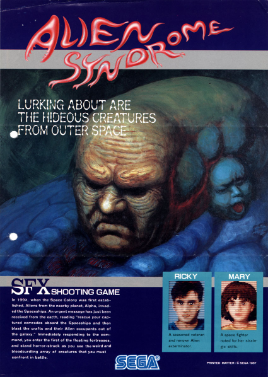
Alien Syndrome is a run and gun video game developed by Sega and released in arcades in 1987, and later ported to the Master System in 1988. The game utilizes a side-scrolling feature that allows the player to take control of either a male (Ricky) or female (Mary) soldier whilst hunting aliens and saving hostages before they run out of time.

Mischief Makers is a side-scrolling platform game developed for the Nintendo 64 gaming console by Treasure, and published in 1997 by Enix in Japan and by Nintendo internationally. The player assumes the role of Marina Liteyears, a robotic maid who journeys to rescue her creator, Professor Theo, from the emperor of Planet Clancer. The gameplay is displayed in 2.5D, based on grabbing, shaking, and throwing objects within five worlds and 52 levels.

Dynamite Headdy is a platform video game developed by Treasure and published by Sega for the Sega Genesis in 1994. The game follows a puppet named Headdy in his efforts to stop an evil puppet king from taking over his world. Headdy can throw his head at enemies to defeat them and use it to pull himself to various areas and move objects. The player can find a wide variety of "heads" which act as power-ups that provide different effects and alter gameplay.

Gunstar Heroes is a run and gun video game developed by Treasure and published by Sega. It was Treasure's debut game, originally released for the Sega Genesis in 1993. The game's premise is centered around a pair of characters, the Gunstars, in their efforts to stop an evil empire from recovering four powerful gems. The characters can fire guns and perform a series of acrobatic maneuvers to fight enemies across each stage. There are four weapons in the game which can be combined with one another to create different shot types.

Flicky is a platform game developed by Sega and released as an arcade video game in May 1984. It was licensed to Bally Midway for distribution in the United States. In Flicky, the player controls the eponymous blue bird and must gather all the small birds called Chirps in each round and bring them safely to the exit. There are cat and lizard enemies which can disperse the Chirps and kill the player, but Flicky can use items on the playing field to protect herself and the Chirps from danger.
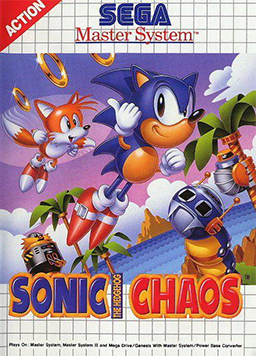
Sonic Chaos is a 1993 platform game published by Sega for the Master System and Game Gear. Players control Sonic the Hedgehog and his sidekick Miles "Tails" Prower in their quest to retrieve the Chaos Emeralds from Doctor Robotnik, who has stolen them to construct nuclear weapons. Gameplay involves running through stages, collecting rings, and defeating enemies. It is largely based on the Master System version of Sonic the Hedgehog 2, and is thus considered a follow-up to that game. Chaos is the first Sonic game for the Master System and Game Gear to feature Tails as a separate playable character with his own unique abilities.

Bonanza Bros. is a 3D-style, 2D side-scrolling stealth action game developed and released by Sega in 1990. It is one of the earliest arcade games powered by the Sega System 24 arcade system board. It was ported to various home systems, including the Mega Drive/Genesis, Master System, PC-Engine/TurboGrafx-CD, and several home computers.
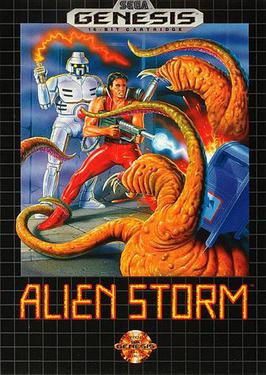
Alien Storm (エイリアンストーム) is a beat 'em up shooter released as an arcade video game by Sega in 1990. It was ported to the Genesis/Mega Drive and Master System. The Mega Drive version was re-released on Wii's Virtual Console in 2007 and was also included on Sonic's Ultimate Genesis Collection for Xbox 360 and PlayStation 3. The game was also re-released on the Nintendo Switch Online + Expansion Pack in 2022.
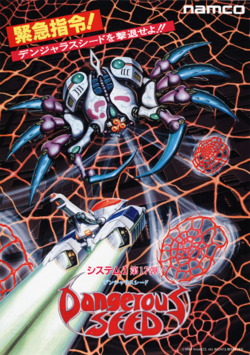
Dangerous Seed is a 1989 vertically scrolling shooter arcade game developed and published by Namco. Controlling one of three different starships, the player is tasked with destroying an alien race known as the Danger Seed before they wipe out all of mankind. Each ship has their own set of weapons and abilities, such as shots that dissolve enemies and target-seeking projectiles, and can sustain multiple hits before being destroyed. The player's ships can also combine into a new ship, the Moon Diver, featuring a stronger shield and additional weapons. It ran on the Namco System 1 hardware.

Rapid Reload, known in Japan as Gunners Heaven (ガンナーズヘヴン), is a run and gun video game developed by Media.Vision and published by Sony Computer Entertainment for the PlayStation in both Japan and Europe in 1995. The game was re-released on the PlayStation Network in Japan in 2007 and in Asia in 2010.

Light Crusader is an action-adventure game developed by Treasure and published by Sega for their Sega Genesis console in 1995. The game was included in the Sega Genesis Classics collections on Steam and other platforms in 2011. It was also included on the Sega Genesis Mini in North America and Sega Mega Drive Mini in PAL regions.
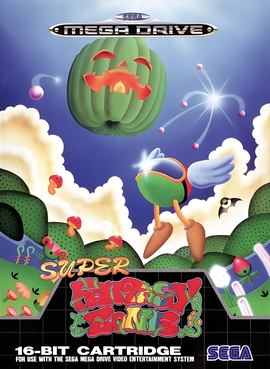
Super Fantasy Zone is a scrolling shooter, part of the Fantasy Zone series. It was released for the Sega Mega Drive in Japan and Europe. Players control the character Opa-Opa on his quest to defeat Dark Menon, and the game plays similarly to previous Fantasy Zone entries. The game plays similarly to Defender, where the screen scrolls in the direction that Opa-Opa is going. The player shoots at enemies to defeat them, collecting gold coins that are used to purchase temporary upgrades that improve Opa-Opa's offensive capabilities and speed, among other things.

Alien Crush is a pinball video game developed by Compile for the PC Engine/TurboGrafx-16. It was released in 1988. The game is the first installment in the Crush Pinball series. It was followed by three sequels, Devil's Crush, Jaki Crush, and Alien Crush Returns. Alien Crush was later rereleased on the Virtual Console and on the PlayStation Network.

McDonald's Treasure Land Adventure is a 1993 platform game developed by Treasure and published by Sega for the Sega Genesis. Based on the McDonald's fast food restaurant chain, specifically its McDonaldland marketing campaign, players control Ronald McDonald in his efforts to retrieve the missing pieces of a map that lead to the location of a buried treasure from a group of villains. Ronald can defeat enemies by using a magic attack and can latch onto hooks with his scarf to reach higher platforms.

Gley Lancer is a 1992 scrolling shooter video game originally developed by NCS Corporation, published in Japan by Masaya and in South Korea by Samsung for the Sega Mega Drive/Genesis. It was re-released in 2019 by Japanese publisher Columbus Circle. It follows Lucia Cabrock, daughter of Earth Federation Navy admiral Ken, who disappeared while fighting in a war between humans and an unknown alien race that possess the ability to teleport, joined by her friend Teim on a journey to save her father by stealing a starfighter. Controlling the titular fighter ship, the player must fight waves of enemies and bosses, while avoiding collision with their projectiles and other obstacles. The Gley Lancer ship is equipped with two satellites options, whose positions and formations are determined by the player.

Soldier Blade is a 1992 vertically scrolling shooter developed and published by Hudson Soft for the TurboGrafx-16. Controlling the titular starship, the player is tasked with completing each of the game's seven stages in order to wipe out the Zeograd Army, an alien race bent on conquering Earth. The game is the fourth entry in the Star Soldier series and shares many similarities with its predecessor Super Star Soldier, with Soldier Blade having a heavy emphasis on speed.

Burning Soldier is a 1994 rail shooter video game developed by Genki and originally published by Panasonic and Pack-In-Video in North America, Japan and Europe exclusively for the 3DO Interactive Multiplayer. The first title created by Genki for the 3DO platform, the game is set in a futuristic Solar System in 2095 where a war against humanity erupts with the arrival of the Kaisertian alien race, as players assume the role of an Earth Defense Force fighter pilot taking control of the mecha-style Strike space fighter craft in an effort to overthrow the invaders and end the conflict. Its gameplay mainly consists of shooting mixed alongside full motion video with sprite-based enemies imposed on them using a main two-button configuration.
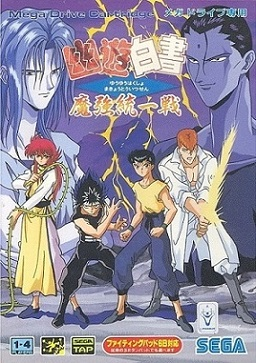
Yu Yu Hakusho Makyō Tōitsusen is a 1994 fighting game developed by Treasure and published by Sega for the Mega Drive. It is based on the manga series Yu Yu Hakusho by Yoshihiro Togashi. The plot follows the protagonist Yusuke Urameshi, who is tasked by the ruler of the afterlife with solving detective-style cases involving both humans and demons threatening the living world. The story begins to focus heavily on martial arts battles as it progresses.

Lone Soldier is an action-adventure/shooter video game developed by British studio Tempest Software for the PlayStation. The game was released in January 1996 in Europe and on 4 October 1996 in Japan. The game features a single playable main character, a lone soldier armed with various weapons, with the goal of killing enemy forces to progress, eventually defeating terrorist leaders and an intergalactic alien army. The game has a third person view, with the player battling through traditional war settings such as jungle, canyon and city, and also a more futuristic space environment.






















